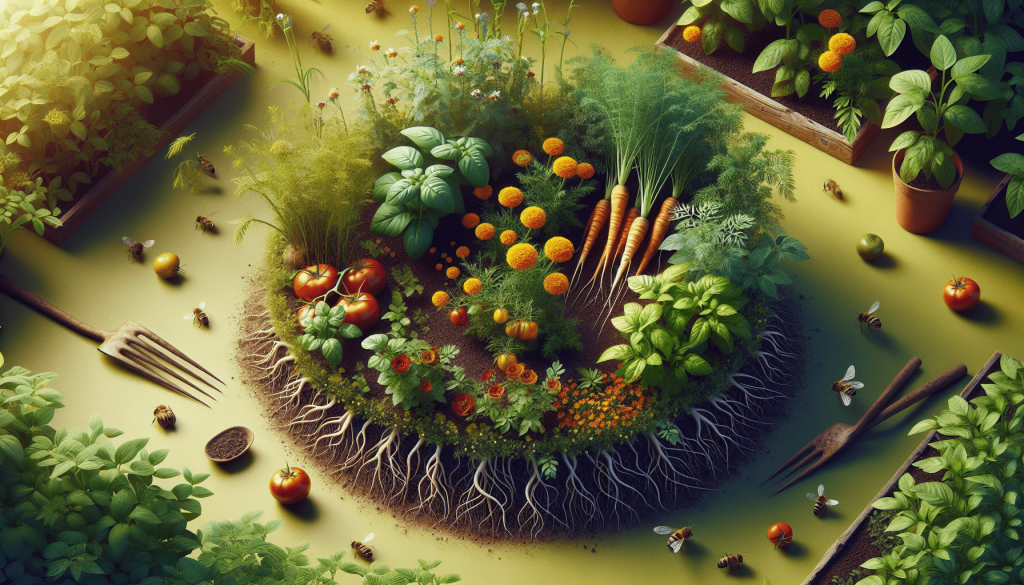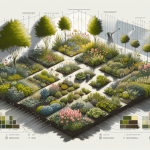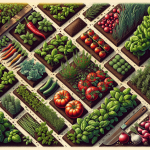This post may contain affiliate links. As an Amazon Associate, we may earn commissions from qualifying purchases.
Are you a passionate gardener looking to optimize your plant growth and overall garden health? If so, companion planting might just be the solution you’ve been seeking. By strategically planting certain combinations of plants, you can harness the power of nature’s symbiotic relationships, enhancing yields, deterring pests, and improving overall plant health. From repelling harmful insects to attracting beneficial pollinators, companion planting offers a range of benefits that can transform your garden into a thriving ecosystem. Discover the secrets of this age-old gardening technique and unlock the full potential of your green thumb.

Increased Biodiversity in the Garden
Diverse plant species attract a wider range of beneficial insects
When you incorporate a variety of plant species in your garden, you create a welcoming environment for a diverse range of beneficial insects. These insects play a crucial role in pollination and natural pest control. By attracting a broader spectrum of insects, you can create a balanced and sustainable ecosystem in your garden.
Promotes overall ecosystem health and resilience
A garden with increased biodiversity is more resilient to environmental changes and disturbances. The different plant species work together to create a harmonious ecosystem, where each plant has its role to play. This diversity helps to maintain the overall health and balance of the garden, making it less susceptible to disease outbreaks or pest infestations.
Reduces the risk of pest outbreaks
By planting a diverse range of companion plants, you can effectively deter pest outbreaks in your garden. Certain companion plants have natural properties that repel pests through scent or chemical compounds. By incorporating these plants into your garden, you can reduce the risk of pest infestations and the need for chemical pesticides.
Natural Pest Control
Companion plants repel pests through scent or chemical compounds
Companion planting involves strategically placing plants next to each other to deter pests naturally. Some plants naturally repel pests through their scent or by releasing chemicals that act as natural insecticides. For example, planting marigolds alongside your vegetables can deter aphids and nematodes from damaging your crops.
Provides habitats for natural predators of garden pests
In addition to repelling pests, companion planting creates habitats for natural predators. Many insects, such as ladybugs and lacewings, feed on garden pests. By attracting and providing habitats for these beneficial insects, you can control pests in your garden without the use of harmful chemicals.
Reduces the need for chemical pesticides
Companion planting can significantly reduce the need for chemical pesticides in your garden. By utilizing natural methods of pest control, you can minimize the negative impacts associated with chemical pesticides, such as harm to beneficial insects, soil degradation, and potential health risks. Not only does this benefit the environment, but it also promotes a healthier and more sustainable garden.
Improved Nutrient Cycling
Some plants have deep roots that bring up nutrients from lower soil layers
Certain plants, such as legumes, have deep roots that can reach nutrients in lower soil layers. These deep-rooted plants contribute to improved nutrient cycling in the garden by extracting essential nutrients from deeper soil layers and bringing them up to the surface. This helps to ensure that all plants in the garden have access to an ample supply of nutrients.
Nitrogen-fixing plants enrich the soil with this essential nutrient
Nitrogen-fixing plants, such as beans and peas, have the ability to convert atmospheric nitrogen into a form that plants can utilize. By planting nitrogen-fixing plants in your garden, you can naturally enrich the soil with this essential nutrient. This reduces the need for synthetic fertilizers and promotes a more sustainable and environmentally friendly approach to gardening.
Beneficial relationships between plants enhance nutrient availability
Certain plants have symbiotic relationships with beneficial soil microorganisms, such as mycorrhizal fungi. These relationships enhance nutrient availability by improving the absorption and transport of nutrients to plants’ roots. By incorporating companion plants that foster these beneficial relationships, you can maximize nutrient availability in your garden and support the health and growth of your plants.
Weed Suppression
Companion plants can create a dense canopy that shades out weeds
Companion planting can effectively prevent weed growth in your garden. By selecting companion plants that create a dense canopy, you can shade out weed seeds, preventing them from germinating and taking hold in your garden. This natural weed suppression method reduces the need for herbicides and minimizes the competition between weeds and desirable plants for nutrients and water.
Certain plants release chemicals that inhibit weed germination and growth
Some companion plants release chemicals known as allelopathic compounds that inhibit weed germination and growth. These plants, such as sunflowers and buckwheat, can be used strategically to suppress weeds in specific areas of your garden. By harnessing the natural allelopathic properties of certain plants, you can maintain a weed-free garden without resorting to chemical herbicides.
Reduces the need for herbicides
Companion planting significantly reduces the need for herbicides in your garden. By utilizing natural methods of weed suppression, you can minimize the negative impacts associated with herbicides, such as soil contamination and harm to beneficial insects. This promotes a healthier and more environmentally friendly garden while reducing your reliance on chemical interventions.

Enhanced Soil Health
Different plant types improve soil structure and prevent erosion
Companion planting contributes to enhanced soil health by incorporating different types of plants that work together to improve soil structure and prevent erosion. Some plants have deep taproots that can break through compacted soil, improving its structure and allowing for better water infiltration and root penetration. Additionally, the variety of plant species helps to anchor the soil, reducing the risk of erosion.
Some plants increase organic matter content and water-holding capacity
Certain companion plants, such as legumes and cover crops, have the ability to increase the organic matter content of the soil. When these plants are incorporated into your garden, they contribute to the accumulation of organic matter, which improves soil fertility and water-holding capacity. This, in turn, benefits the overall health and productivity of your garden.
Complementary root systems improve nutrient uptake and soil aeration
Companion plants with complementary root systems can improve nutrient uptake and soil aeration. For example, plants with deep taproots can access nutrients in deeper soil layers, while shallow-rooted plants help to distribute water and nutrients in the topsoil. This synergy between plants enhances the overall nutrient availability in the garden and ensures adequate soil aeration, promoting healthier plant growth.
Attracting Pollinators
Certain companion plants attract bees, butterflies, and other pollinators
Companion planting can help attract a diverse range of pollinators to your garden. Flowers, such as sunflowers, zinnias, and lavender, are attractive to bees, butterflies, and other pollinators. By incorporating these companion plants, you can increase the presence of pollinators in your garden, which improves pollination rates and boosts the overall productivity of your crops.
Improves pollination rates and fruit set in crops
When pollinators are abundant in your garden, they increase the chances of successful pollination and fruit set in your crops. Proper pollination is crucial for the development of healthy and abundant fruits, vegetables, and flowers. By creating an inviting environment for pollinators through companion planting, you can enhance the productivity of your garden and enjoy a bountiful harvest.
Increases overall garden productivity
The presence of pollinators due to companion planting can significantly increase the overall productivity of your garden. Improved pollination rates lead to better fruit set, resulting in larger harvests of high-quality produce. This increased productivity not only benefits your own food supply but also supports the local ecosystem by providing food sources for pollinators and contributing to biodiversity.
Maximizing Garden Space
Tall plants provide shade for shorter, shade-tolerant companion plants
Companion planting allows you to maximize the space in your garden by taking advantage of different plant heights and growth habits. Planting tall or trellised plants can provide shade for shorter, shade-tolerant companion plants. This strategic use of vertical space allows you to grow a greater variety of plants without overcrowding, optimizing your garden’s productivity.
Vining plants can be trained to grow vertically, saving horizontal space
Vining plants, such as cucumbers or beans, can be trained to grow vertically on trellises or stakes. By utilizing vertical gardening techniques, you can save horizontal space and make the most of limited gardening areas. This is particularly beneficial for small gardens or urban spaces where every inch counts.
Allows for efficient use of limited gardening areas
Companion planting enables you to efficiently use limited gardening areas, making it possible to grow a wide range of plants even in small spaces. By carefully selecting companion plants that complement each other’s growth habits and spacing requirements, you can maximize the productivity of your garden, regardless of its size. This efficient use of space allows you to enjoy a flourishing garden, even if you have limited room to work with.
Improved Flavor and Crop Quality
Some companion plants enhance the flavor and aroma of nearby crops
Companion planting can enhance the flavor and aroma of nearby crops by creating favorable growing conditions and chemical interactions. For example, growing basil or dill alongside tomatoes can enhance their flavor and make them more aromatic. These beneficial interactions can result in tastier and more flavorful harvests that are a delight to your senses.
Certain combinations can help deter pests that may damage crop quality
Companion planting not only improves flavor but also helps to protect the quality of your crops. Some companion plants have natural properties that repel or confuse pests, reducing the risk of damage to your harvest. For example, planting onions or chives alongside carrots can help deter carrot fly and other pests that may compromise the quality of your carrots.
Promotes healthier and tastier produce
By incorporating companion planting techniques, you can promote healthier and tastier produce in your garden. The symbiotic relationships between companion plants enhance the growing conditions, nutrient availability, and pest resistance of your crops. As a result, you can enjoy the satisfaction of harvesting fruits, vegetables, and herbs that are not only visually appealing but also full of flavor and nutritional value.
Companion Plants for Microclimates
Certain companion plants can provide shade or wind protection to sensitive crops
Companion planting can address microclimate challenges in your garden by strategically selecting plants that provide shade or wind protection. For example, planting taller sunflowers or corn can shade more delicate and sun-sensitive plants from excessive heat. Similarly, selecting wind-resistant plants, such as sturdy herbs or grasses, can protect more vulnerable crops from harsh winds.
Helps create optimal growing conditions for different plant species
By incorporating companion plants for microclimates, you can create optimal growing conditions for different plant species within your garden. Some plants require specific temperature, humidity, or light levels to thrive. By placing companion plants that offer shade, reduce wind exposure, or create suitable microenvironments, you can ensure that each plant has the best conditions for growth and productivity.
Increases the overall resilience of the garden
Companion planting for microclimates contributes to the overall resilience of your garden. By addressing potential challenges posed by temperature fluctuations, wind, or excessive sunlight, you can help your plants withstand adverse conditions and minimize stress. This resilience allows your garden to thrive in a range of conditions, ensuring a successful growing season and a higher likelihood of a bountiful harvest.
Cultural and Aesthetic Benefits
Companion planting can reflect cultural traditions and aesthetics
Companion planting goes beyond providing practical benefits to your garden; it can also reflect cultural traditions and aesthetics. You can incorporate plants that hold significance in your cultural heritage or that symbolize certain meanings. This connection to your heritage or personal values adds a meaningful and unique dimension to your garden, making it a reflection of who you are.
Creates visually appealing garden designs and color palettes
Companion planting offers the opportunity to create visually appealing garden designs and color palettes. By carefully selecting companion plants with complementary colors, textures, and growth habits, you can create a harmonious and aesthetically pleasing garden. The interplay of different plants adds depth and visual interest, enhancing the overall beauty of your garden space.
Allows for the creation of themed or medicinal herb gardens
Companion planting allows you to design themed gardens or grow specific plants for their medicinal properties. You can create a fragrant herb garden with companion plants like lavender, rosemary, and thyme. Alternatively, you can focus on growing medicinal herbs by selecting companion plants that complement their growth and healing properties. These themed or medicinal herb gardens not only provide practical benefits but also contribute to the overall ambiance and enjoyment of your garden.
In conclusion, companion planting offers numerous benefits that contribute to the success and sustainability of your garden. By diversifying your plant species, attracting beneficial insects, and promoting natural pest control, your garden becomes a thriving ecosystem that is less prone to pests and diseases. The improved nutrient cycling, weed suppression, and soil health contribute to the overall productivity and health of your plants. Attracting pollinators enhances the fruit set and quality of your crops, while maximizing garden space allows you to make the most of limited gardening areas. The improved flavor and aesthetic appeal, along with the cultural and medicinal benefits, make companion planting a holistic approach to gardening that can enhance your gardening experience and create a vibrant and thriving garden.








